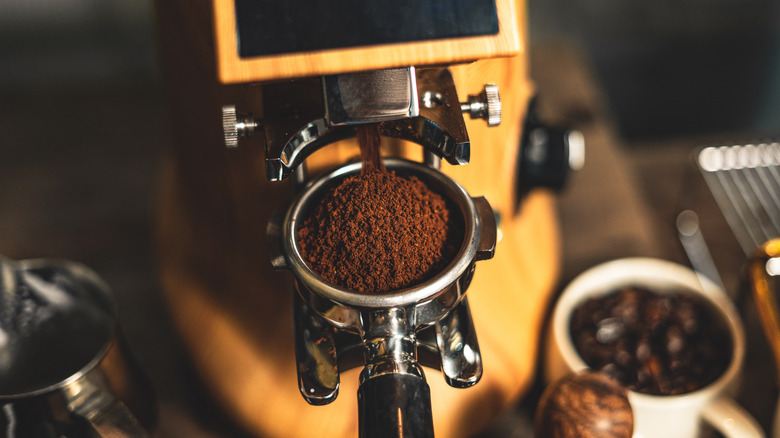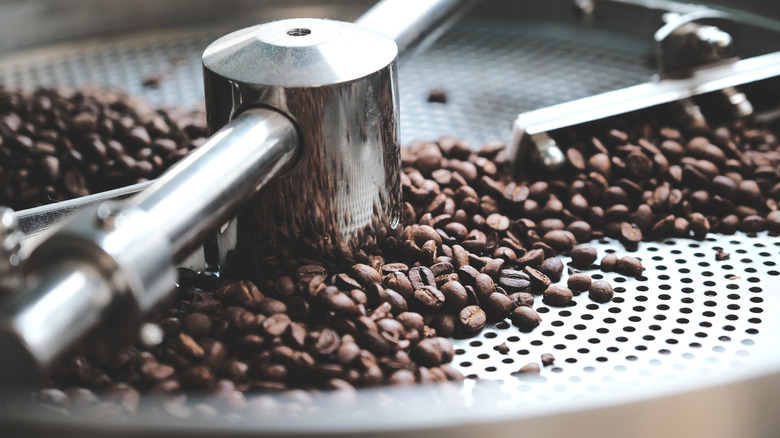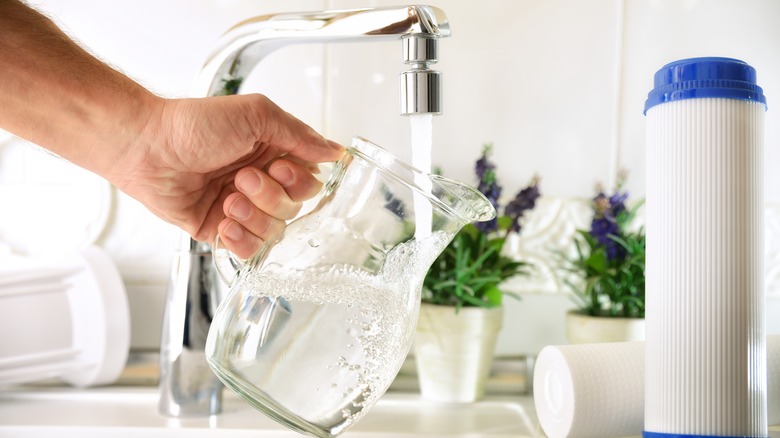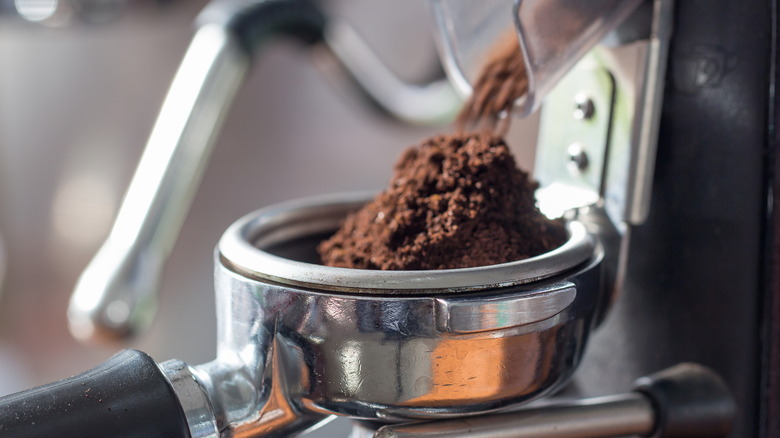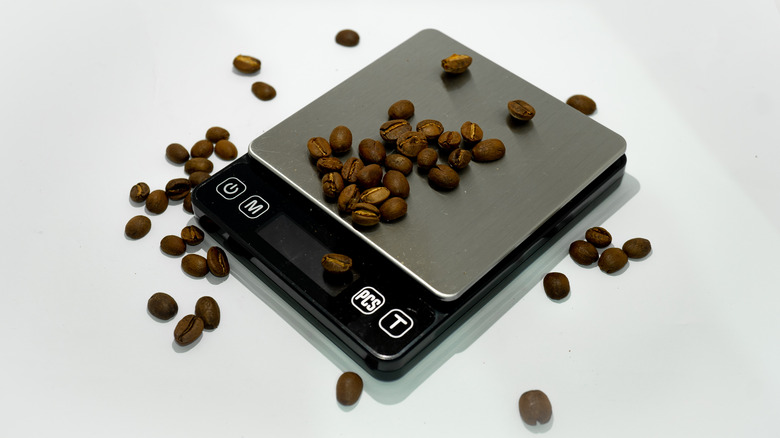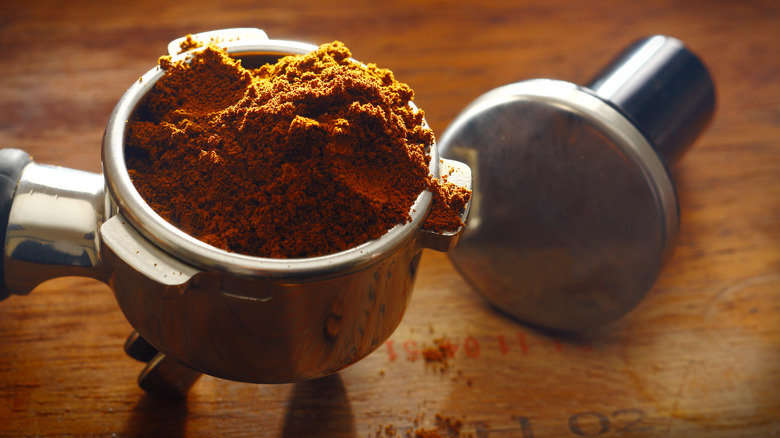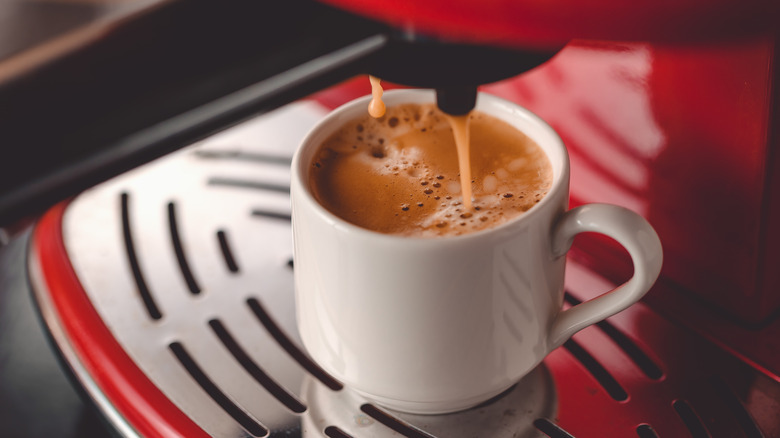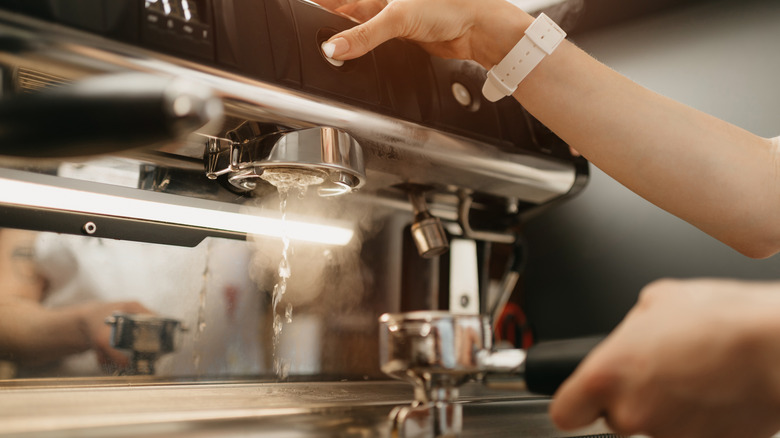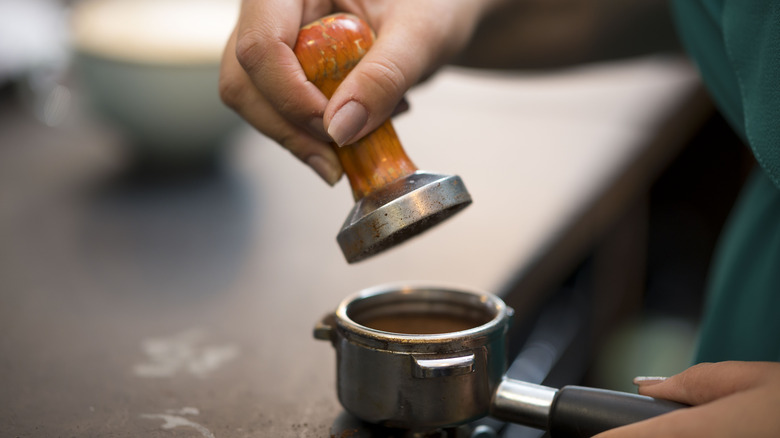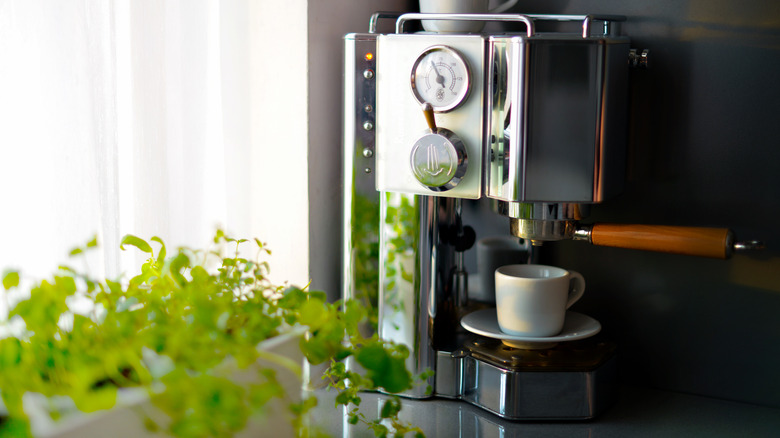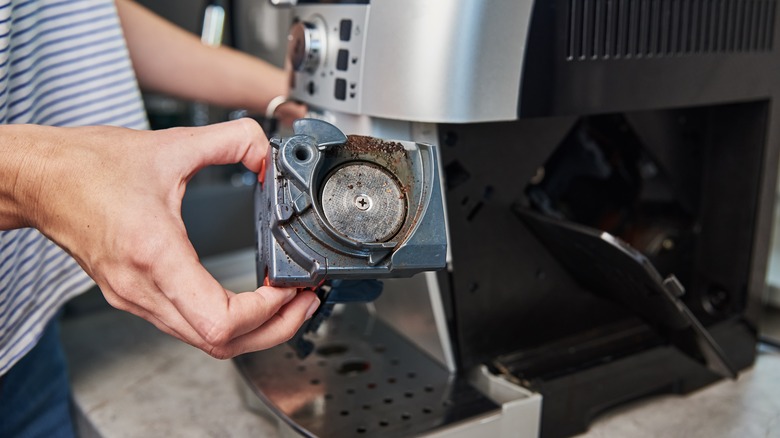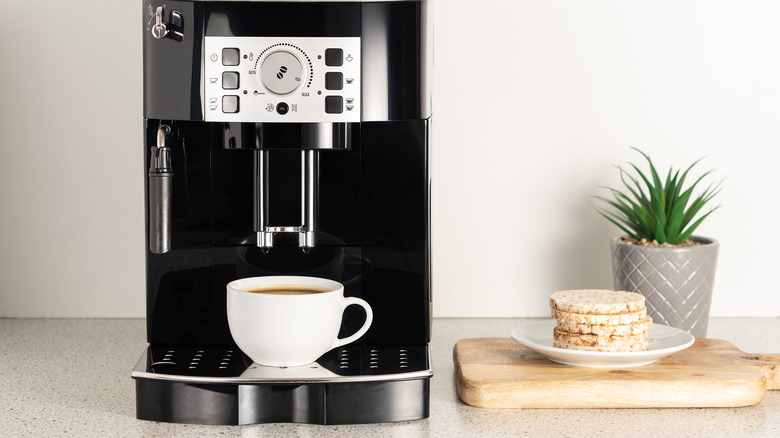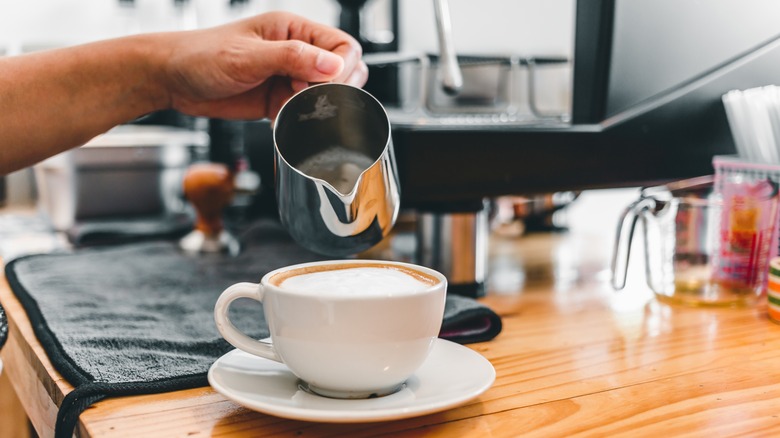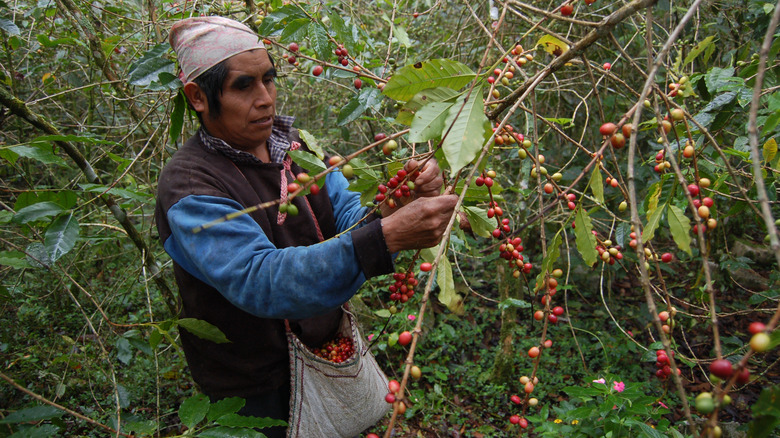13 Mistakes To Avoid When Making Espresso At Home
Make no doubt about it: Americans love coffee. Around 75% of people in a 2022 coffee survey reported consuming the nation's favorite beverage every day. Before the Covid-19 pandemic, the National Coffee Association found that around 36% of all coffee drinking was done outside the home — at work, at coffee shops, and elsewhere. Once dining restrictions went into place, however, Americans' coffee habits drastically changed.
This shift in life's daily routine gave birth to a home barista movement, notes The Food Institute. Although the virus has largely receded in our collective lives, research that Americans' consumption of coffee outside the home still hasn't reached pre-pandemic levels. And despite reports of feeling financially vulnerable, coffee is such a staple in American culture that two in five people are still willing to pay more money for better coffee at home.
To get the biggest bang for your buck in your at-home brew, we spoke with Michelle Kawahara, training manager for Lavazza. She shared her expert insight into the art and science of espresso exclusively with Daily Meal. Here's how you can go from "covidista" to a true (home) pro in no time.
Not using freshly roasted beans
When it comes to making great at-home espresso, Michelle Kawahara doesn't mince words: "The number one tip is to definitely use fresh coffee beans," she says. "Even if you have the fanciest machine but stale or old espresso, your fancy machine cannot magically make your coffee taste better." Freshly roasted beans will give your espresso the richest, freshest flavor possible.
When experts like Kawahara say fresh, they mean it. Although there's no consensus on exact dates, most coffee connoisseurs agree that fresh beans have been roasted recently — at the most, around three weeks ago, not several months ago. Roasted beans kept in a dry, cool area in an airtight container at room temperature or lower can have an extended shelf life. But the longer the coffee sits on the counter, the more the quality begins to slowly degrade over time. Instead of stocking up on coffee in bulk and storing it for a long time, regularly "invest in fresh espresso beans!" advises Kawahara.
Not using good water
Espresso has just two ingredients: coffee and water. And water makes up a whopping 98% of that equation. No wonder good H2O is essential for a good cup o' joe. "Tap water can have a high concentration of minerals and imbalanced pH levels which can cause coffee to taste just like that," explains espresso expert Michelle Kawahara. She suggests using filtered water to reduce bitterness and keep coffee from tasting astringent.
For folks that don't have access to a reverse osmosis filter that removes sediment and chlorine from tap water, Kawahara suggests adding mineral packets from Third Wave Water to make better coffee. "There's a lot to think about when using the right water, " she says. For example, if your coffee has a heavy, chalky mouth feel with low acidity, your water might be too high in alkalinity and minerals. If it's too low in alkalinity, your brew might taste super sour. Kawahara encourages everyone to conduct an experiment with different waters with pour-over coffee to taste the difference.
Not using the right grind
Good espresso is all about proper extraction. The flavor of the beans is extracted by pulling water through the ground coffee beans. How quickly and efficiently water passes through depends on the available surface area of the beans — in other words, the size of the grind. And how long the water takes to pass through the grinds affects the taste of the coffee.
In general, espresso machines are designed to use a consistently fine grind somewhere between the texture of sand, sugar, and salt. The exact size of the grind, however, is dependent on the particular beans and espresso machine. Even identical grinders — where one has been used significantly more than the other — produce grinds of different sizes. You may need to experiment a bit to find the right size for your beans, grinder, and machine. If your espresso makes you pucker, adjust to an ultra-fine grind. To fix bitter coffee, try a coarser, medium-fine grind.
Remember, too, to grind your beans immediately before brewing. Mere minutes after grinding, the coffee begins to lose some of its most delicate aromatic compounds. Like with water and flavor extraction, the greater surface area of the beans exposed to the air, the more the beans begin to oxidize and lose flavor.
Not measuring everything precisely
Eyeballing your espresso measurements may make you feel like a seasoned pro. But even coffee experts like Michelle Kawahara measure their beans and water — every time. Estimating instead of measuring makes replicating your results and properly adjusting your recipes very difficult. Espresso is an art of small numbers. Just 2 grams more or less puts you 10% off of an espresso recipe calling for 20 grams of coffee.
Solve this mistake by investing in a scale, says Michelle Kawahara. "You can be more precise in the amount of coffee and water you're using," she says. A scale, especially as you're learning to perfect your brew, can provide accurate measurements you can use to find the perfect espresso settings for your machine.
Kawahara raves, "My favorite scale is anything Acaia makes. It's a little pricey, but it's precise and easy to use." Because it's such a quick and easy step, measuring your ingredients can make the difference between espresso that's bene and espresso that's benissimo.
Adding more coffee to get more flavor
Some novice home baristas assume incorrectly that if you add more coffee, you can slow the water down and therefore extract more flavor from the beans. And while adding extra coffee to the basket can indeed increase brewing time, this newbie method is certainly not the most efficient use of your freshly roasted, recently purchased beans. With high-quality coffee, you're better off using less of it and having your water go through more slowly to extract the most flavor from the beans used.
Solving your espresso flavor problems by adding more coffee in the basket might even create a bigger problem: Extra grinds in the basket increase the overall pressure on your espresso maker. Especially in lower-end machines, the added pressure can cause technical issues over time. Instead, get the most flavor from the smallest amount of beans by considering the freshness of your roast, the quality of your water, and the size of your grind. Adjusting those elements will provide you with a better-tasting, less expensive, and less wasteful espresso far more than adding more coffee.
Not properly adjusting the strength
Forget what you think you know about coffee strength. A great at-home espresso is not about the amount of caffeine, the darkness of roast, or the rating on the label. According to the industry non-profit Speciality Coffee Association (SCA), brew strength is calculated by the total amount of dissolved coffee solids per liter of water. The SCA's Golden Cup Standard yields between 11.5 grams and 13.5 grams of dissolved solids, extracting between 18% and 22% of the coffee solubles. Espressos that meet these requirements fall into the sweet spot — 1.15% to 1.35% — for the ideal cup of joe on the SCAA's classic brewing control chart.
Michelle Kawahara says you can get that Golden Cup strength every morning by following the SCA's guidelines for the coffee-to-water ratio: around 1:18. The SCA recommends using 55 grams of coffee per liter of water, plus or minus 10%. "But you can definitely adjust to your preference," adds Kawahara. For stronger coffee, she advises home baristas to use a smaller ratio, like 1:15. She also suggests experimenting and comparing coffees of different ratios to find the right strength for you.
Not purging your machine for proper temperature
To get the most consistent extraction, pay attention to temperature. It plays a bigger role in the flavor of your espresso than you might expect. The Specialty Coffee Association advises that water should touch the grounds at no more than 5 degrees Fahrenheit over or under 200 degrees Fahrenheit. If the water is even just 2 degrees Fahrenheit off of those parameters, it can affect the flavor.
When an espresso machine is idle, the water inside tends to overheat. Remove the group handle, and you'll likely see extra steam and sputtering water coming from the group head. If you brew your coffee using this overheated water, you'll likely get a more sour taste. Instead, use a cooling flush to keep the group head clean and ensure the water is back in the ideal brewing temperature range before pulling the next shot.
Another temperature tip: Don't pour your perfectly hot coffee into a cold cup. Pre-heat yours with hot water or steam for that professional touch every morning.
Not practicing proper tamping technique
Well tamped grounds play a big role in a great tasting coffee. It's this tightly packed puck in the portafilter from which a great cup of espresso can be extracted. If your tamp is uneven, however, the puck can fracture and affect the taste of your brew. In unevenly tamped grounds, the water travels faster through the gaps and crannies, not allowing enough time to extract the ideal amount of coffee compounds. Evenly and sufficiently tamped coffee flows through at a slower speed, giving you that perfect cup of joe.
Repeat this process for great espresso day after day: Level off the grounds in the portafilter. Stand with your tamping-side hip against the counter, then get a good grip on the tamper. Apply around 15 pounds of even pressure to create the puck. Then press even harder, 20 to 30 pounds of pressure. Don't worry — it's next to impossible to over tamp your coffee. Then pull up with a twist to "polish" off the puck. Make sure the puck looks solid and that no coffee grounds remain on the edges of the portafilter (best practices for machine maintenance). Now you're ready to brew!
Not regularly maintaining your machine
Like any high-end device, espresso equipment requires regular cleaning. Maintaining your machine will not only help it function better for longer, your coffee itself will improve in taste. With each pull of espresso, you'll need to purge your group head. Just remove the portafilter after the shot has been pulled and clean the coffee out. Then purge that group head — even if it looks clear — to expel any excess oils or grounds that may have gotten caught. This prevents grime from building up over time.
You'll also want to clear out the steam tip both before and after you use it. Keep a damp rag nearby to wrap around the wand while you purge it for a couple seconds. This keeps any excess water from the tip from finding its way into your milk and keeps the wand clean for years of use. These small, daily habits can avert deeper, more labor intensive cleaning — or even machine repair later down the road.
Not deep cleaning periodically
While regular maintenance may be the most important espresso cleaning habit, you'll also need to perform regular deep cleaning for all your equipment. Depending on your water system, says Michelle Kawahara, home baristas should descale the hard water buildup in their machines every six months. If you're using reverse osmosis or filtered water, "You shouldn't have to descale every week," she says. White vinegar works as a DIY descaler, or Kawahara recommends this natural descaler from Urnex.
Don't forget about your grinder! If you love to switch up your beans on the regular, you'll want to deep clean your grinder about once a week. Kawahara says this is the best way to prevent any flavor crossover. She recommends using Grinds by Urnex – plant-based tabs that remove coffee particles and oils from burr grinders without having to disassemble them. This deep cleaning doesn't take a lot of time and can provide you with a better cup of espresso while keeping your equipment in good working order. You're looking more like a pro barista by the minute!
Paying attention to bar labeling
Looking for a new espresso machine? Ignore the bar labeling on the box. A machine with bar pressure of 18 isn't necessarily a better machine than one with a bar pressure of 15. At the end of the day, the bar pressure that really matters is nine bars — the amount of pressure necessary to extract espresso, says Michelle Kawahara. If you've got the nine bars to make espresso, you've got the one to two bars of pressure you'll need to steam milk. Check and mate.
Instead of looking for the machine with the most bar pressure, look for a machine that matches your needs. "There are a lot of great machines out there that do the job, and it really depends on what you're looking for," explains Kawahara. "Some people are okay with the machine that's 'all-in-one,' and most would prefer a grinder and an espresso machine ... Whatever machine they get, the most important thing is to use fresh beans!"
Using the wrong milk
Sometimes you want more than just coffee. Whether you're a vegan or an omnivore, there are better milks to use when making a cappuccino, latte, or macchiato. And with all the hard work you've put into brewing the perfect at-home espresso, you wouldn't want to detract from your efforts by using low-fat milk. While a pro might be able to make beautiful latte art with skim milk, at home you'll likely just get tons of big bubbles. Low-fat milk tends to plop instead of pour, and the texture and consistency are lacking compared to full-fat milk.
Dairy or non-dairy, the smoothest, most velvety milks have ample fat and protein. Steaming your milk not only heats up the milk but it also introduces air. The proteins in the milk bend around that air, creating bubbles. The more fat a milk has, the smaller the bubbles are and the easier that foam is to manipulate. Full-fat milks are silky, creamy, tasty, and more flavorful than their low-fat counterparts.
For plant-based milks, look for options labeled barista blend. These formulations have the necessary protein and fat to create the proper texture, flavor, and consistency, even for the most decorative of lattes.
Overlooking the origin of your coffee
The perfect home brewing technique, the best beans, and the highest-end equipment aren't the only factors that affect the taste of your espresso. It may sound crazy, but research shows that consumers report ethically harvest coffee tasting better ... even if that "taste" only comes from a sense of moral satisfaction from doing good in the world.
That's because coffee is generally sourced from small-scale producers in developing nations. A number of certifications – Fairtrade America, Fair Trade USA, Fair Trade International, and Rainforest Alliance Certified – aim to indicate that farmers were paid fair wages and that the coffee farming practices are sustainable. Because the trade is direct, these humane and eco-friendly behaviors don't result in higher costs for consumers. Direct trade between coffee farmers in the Global South and buyers in the Global North also helps keep more money in the local coffee farming economies and helps build community development.
The next time you sip your ethically sourced home brew, take a moment to relish in the feeling that your coffee is making life better for someone else. Espresso never tasted so good.
